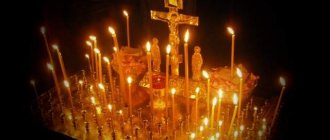Spiritual death
One of the important elements of the doctrine of the totalitarian obsessive sect of Jehovah's Witnesses is the statement that the soul ceases to exist after the death of a person, i.e. dies along with the body: “The soul that sins will die” (Ezek. 18:4). This reference to the biblical text is perhaps the most clear demonstration of how false teachings are built on the basis of biblical sayings taken out of context. If you continue reading chapter 18 of the prophet Ezekiel, it becomes clear that we are talking about the spiritual death of the sinner, but the righteous “will certainly live” (ibid., verse 9). And the fact that a person who has sinned dies spiritually is discussed in the parable of the prodigal son: “My son was dead and is alive again” (Luke 15:24).
God predicted Adam's death on the same day that the first man would eat of the tree of the knowledge of good and evil (Gen. 2:17). Having committed the Fall, Adam and his wife Eve did not die a physical death on the same day. They died a spiritual death - their souls moved away from God. “The soul that sins shall die” (Ezek. 18:4) - this is how the meaning of the verse is more accurately conveyed. This is confirmed by the prophet Isaiah: “Your iniquities have created a division between you and your God” (Is. 59:2). The holy fathers of the Church also spoke about the spiritual death of the soul: “The removal of the soul from God is death for it” (St. Simeon the New Theologian). It is difficult to disagree with the statement of Ecclesiastes, which “witnesses” often like to quote, that “in the grave... there is no work, no reflection, no knowledge, no wisdom” (Eccl. 9:10), but this does not mean the destruction of the soul - just after death, a person’s soul is freed from earthly attachments, because it returns to God, as evidenced by the same Ecclesiastes (Eccl. 12:7).
During physical death, the spiritual component of a person leaves his body. The physical body, devoid of soul and spirit, will, of course, have “neither work, nor reflection, nor knowledge, nor wisdom” (Eccl. 9:10). The Savior’s words about Lazarus falling asleep (John 11:11) precisely confirm the Orthodox teaching about the dormition of souls before the resurrection in Christ, and not about their destruction, as Jehovah’s Witnesses try to interpret these words. Deceased, i.e. asleep, the Church calls dead people, emphasizing the temporary nature of separation from our loved ones, whose souls have gone to the Lord. And if a person’s soul ceased to exist after his death, then the first martyr Stephen would not have exclaimed: “Lord Jesus! receive my spirit” (Acts 7:59).
Why do we hurt so much?
The imagination projects personal fear and onto those who are dear to us, we fear for them. Love, affection, just the habit of being nearby develops spiritual connections and support points, provides material and physical support, thanks to which we feel confident in this world. After the death of a loved one, one of the supports collapses - our confidence decreases, we become afraid.
The belief that there is something at the end of the tunnel will help you accept death.
Another reason for our grief is remorse: what could we have done, but did not do for a person during our lifetime? How did we offend him? Why didn't you ask for forgiveness? Imaginary or deserved feelings of guilt occupy our thoughts again and again. This is not the correct attitude towards death, but a vicious circle, from which it is very difficult to get out without the help of a psychologist or spiritual mentor.
A good psychologist will help you develop a correct attitude towards death.
The king and the sorceress
In the book of Kings we read that, agonizing in anticipation of a great misfortune, King Saul turned to a sorceress (spiritualist), who was engaged in summoning the souls of the departed (which was an abomination before God). We read: “Then the woman asked: whom should I bring out to you? And he answered: “Bring out Samuel to me” (1 Sam. 28:11), and further: “...an old man comes out of the land, dressed in long clothes. Then Saul knew that it was Samuel, and fell face down on the ground” (1 Sam. 28:14). The sorceress, according to custom, wanted to summon a certain ghost, the nature of which she could only guess, but she saw someone whom she did not expect to see at all. If the sectarians were right, and it was an ordinary spiritualistic session, at which a demon appeared in the guise of Samuel (after all, the sorceress could not, indeed, summon the spirit of the righteous!), then her reaction is incomprehensible, for she was accustomed to communicating with fallen spirits. But contrary to the expectations of the spiritualist herself, a real miracle happened: God clothed Samuel’s disembodied soul in some semblance of a body in order to once again express to the apostate His unyielding will about him and his descendants: “... why do you ask me, when the Lord departed from you and became your enemy? The Lord will do what He spoke through me; The Lord will take the kingdom out of your hands” (1 Sam. 28:17).
If the sectarians (Jehovah's Witnesses, Adventists, etc.) were right, then the demon could give a true prophecy of “what will happen” before it happened by the will of God. But demons serve their master - the father of lies, which is why they are so consistent in untruth. Only God could create a true miracle or allow it to happen among even the wicked for the final judgment and sentence. It is to this event that Jesus, the son of Sirach, testifies: “He prophesied even after his death, and predicted his death to the king, and in prophecy he lifted up his voice from the earth, that the lawless people would be destroyed” (Sir. 46:23). And even if we agree with the position of the “witnesses” that this information was revealed to man by demons, then again we must recognize the fact of the existence of the subject himself (who was possessed by a demon), who perceives demonic suggestions after the death of the bodily shell.
Common grave of humanity
If there is no immortality of the soul, then there is no hell, say the “witnesses”. Hell, in their understanding (Heb. Sheol) is the common grave of humanity, in which the souls of sinners will rest, deprived of the opportunity to be resurrected for their sins, and fiery Gehenna, which the Savior repeatedly spoke about, is just a burning landfill in the valley of Ginnom on outskirts of Jerusalem. Indeed, the valley of Ginnom, where idolatrous Jews once sacrificed their children to the pagan idol Moloch, burning them alive, during the earthly life of Christ was a place for the destruction of city sewage, the corpses of executed criminals and dead animals, for which a fire was always burning in the valley . It would be strange if Christ, speaking about Gehenna (Matt. 5:29; 10:28. Mark 9:43-45, etc.), claimed that the bodies and souls of sinners would be destroyed in a suburban landfill. Christ called the valley of Ginnom - fiery Gehenna, which became a place of horror and disgust for the Israelis, a symbol of the eternal torment of unrepentant sinners. That is why Jehovah's Witnesses are afraid of the true meaning of this expression and, apparently, their fears are not in vain.
In the image and likeness
Man has a certain spiritual essence: “The spirit is in man, and the breath of the Almighty gives him understanding” (Job 32:8). David (Ps. 50:12) asks God to renew the “right spirit” within him. Man identifies himself precisely with this spiritual essence, calling the bodily shell “a temple of clay” (Job 4:19). The Apostle Paul states that “when our earthly house, this hut, is destroyed, we have a dwelling place in heaven from God... We, being in this hut, groan under a burden... And as we know that, being settled in the body, we are taken away from the Lord... we desire It is better to leave the body and be with the Lord, and therefore we earnestly strive, whether in or out, to be pleasing to him...” (2 Cor. 5:1-9). This passage clearly proves that man is not just a mechanical combination of the body and the breath of life, forming a living soul, but rather a spiritual being in a bodily shell, because he was created in the image and likeness of God (see Gen. 1:26,27; 5: 1). This completely refutes the attempt to identify a person with his physical body, since “God is spirit” (John 4:24), that is, God is a person who does not have a material body. The Apostle Paul also states, “To me to live is Christ, and to die is gain” (Phil. 1:21). If death is sleeping in the grave without consciousness, then what joy is it for the apostle to die in order to sleep in the grave until the resurrection? What kind of “acquisition” is this then? Or here’s another verse telling about the events on Mount Tabor, where “Moses and Elijah appeared to the apostles” (Matthew 17:3). But it is known from the book of Deuteronomy (32:50) that Moses died on Mount Nebo. How did he end up there at the Transfiguration of the Lord? The Apostle Paul himself states: “If our outer man is decaying, yet our inner man is being renewed day by day” (2 Cor. 4:16). And in the Epistle to the Philippians he will say: “I have a desire to be separated and to be with Christ, because this is incomparably better. But it is more necessary for you to remain in the flesh” (1:23-24). The Apostle John, describing his vision on Patmos, also points to certain souls: “...he saw under the altar the souls of those who had been slain...and they cried out with a loud voice...” (Rev. 6:9-10). We find a consonant thought in the Book of Acts: “He first said about the resurrection of Christ, that His soul was not left in hell, His flesh did not see corruption” (Acts 2:31). Contradictions of the teaching: Further study of all the contradictions in the teaching of Jehovah's Witnesses about the mortality of the human soul through the analysis of various passages of Holy Scripture shows that: - the spirit in man is not just breathing (Job 27:3); — the spirit in a person does not depend on the body (Zech. 12:1); — the spirit leaves a person at the time of death (Ps. 145:4; Matt. 27:50; Mark 15:37; Acts 5:10); - God accepts the spirit of a deceased person (Eccl. 12:7; Job 34:14; Ps. 103:29; Luke 23:46; Acts 7:59); - The body without the spirit is dead (James 2:26; Ezek. 37:8); — The returning spirit resurrects the dead body (Judg. 15:19: Ps. 103:30; Ezek. 37:5,6,10,14; Luke 8:55; Rev. 11:11); — the soul is not only blood and emotions. The soul, unlike the body, cannot be killed (Matthew 10:28); - the spiritual entity has consciousness after physical death (1 Samuel 28:8-19; Isa. 14:9-17; Matt. 17:3, Rev. 6:9-11). And after physical death there is no phase of unconscious sleep, as Seventh-day Adventists claim, since the Lord Jesus Christ himself points to the immortality of the soul in the last hours of His suffering, addressing the prudent thief from the Cross: “Truly I say to you, today you will be with Me in Paradise "(Luke 23:43). In other words, after bodily death, the Lord immediately, and not after the general Resurrection, introduces him first into the heavenly abodes, since “God is not the God of the dead, but of the living, for with Him all are alive” (Luke 20:38; Matt. 22: 32). Scripture says that having created the human body, God “breathed into his nostrils the breath of life” (Gen. 2:7). The Long Catechism says that the “breath of life” is the immortal soul, a being “spiritual and immortal.” However, St. The Fathers say that the “breath of life” is more than just a spiritual substance.
Original sin
The Orthodox Eastern Church has always understood original sin as that “seed of aphids,” that hereditary corruption of nature and the tendency to sin, which all people receive from Adam through birth. Conception and birth are the channel through which ancestral damage is transmitted. “Behold, I was conceived in iniquity, and my mother gave birth to me in sin” (Ps. 50:7), exclaims David, and the Apostle Paul directly connects the sinful corruption of human nature with the sin of our first parents: “Therefore, as by one man sin entered into the world, and death through sin, so death spread to all men, [because] all have sinned in it” (Rom. 5:12).
Thus, original sin is a hereditary damage to the human mental and physical nature, the general tendency of people to sinful acts.
What do the Holy Fathers tell about the immortal soul?
Venerable Macarius of Egypt: “Just as the soul is the life of the body, so in the eternal and heavenly world the life of the soul is the Spirit of God.” St. Ephraim the Syrian: “The soul was created in the image of your Creator, His likeness and His image are imprinted on you - beware of tarnishing the image of God and being condemned by the King, whose image you have desecrated.” Rev. Isidore Pelusiot: “The body lives while the soul is in it, and the soul lives while God’s Spirit is in it. And just as after separation from the soul the body dies, so after the departure of the Holy Spirit the soul lost the blessed life, which is worse than any death.” Saint Gregory of Nyssa: “Man is brought into being by the Creator in order to be animated by the likeness of the Divine and supreme power.” Saint Basil the Great: “The world needs to change if the state of souls passes into a different kind of life. For just as our present life has qualities akin to this world, so the future state of our souls will receive a lot characteristic of its state.” Metropolitan of Moscow Philaret: “Man is not only a body, but also not only a spirit; he is the unity of body and spirit. “And man became a living soul” (Genesis 2:7), that is, as soon as the Creator breathed the breath of life into the body He created, man became a living being, one in consciousness, two in nature. In the teaching of the Holy Scriptures about the spiritual principle of human life, the duality of this principle is sometimes pointed out, for example: “The Word of God is living and active... penetrating even to the dividing of soul and spirit, joints and marrow” (Heb. 4:12). Some of the teachers of the Church also talk about soul and spirit, as if about two different principles of our spiritual nature. But for the apostle, the words “spirit” and “soul” in relation to human nature do not mean different principles, but only the higher and lower sides of the same principle: hence his expressions “spiritual” and “natural” man (1 Cor. 2 :14-15), that is, a person with higher knowledge and illumination from God, who sees into the region of the High, spiritual world, and a person with undeveloped or even dulled spiritual vision, unable in this state to see anything higher than the sensory. The teachers of the Church thought the same, distinguishing between spirit and soul in man, because, speaking about nature in general, they recognized only its two-part, spiritual-physical composition.” Thus, about the similarity of man with God (who is by His nature the purest Spirit) or about the image and likeness of God in man, we can say that most of the Fathers and teachers of the Church connected the image of God in man with his immortal soul. Therefore, the bearer of the image of God in man is his immortal soul. More specifically, the image of God, which consists in the soul’s ability to think, feel, carry out decisions made, as well as its immortality as the impossibility of destruction or annihilation. Therefore, the Orthodox Catechism says that the image of God is a gift of God, which is expressed in the ability to be a partaker of Divine life and participate in divine perfections. And the likeness of God is the manifestation of this gift in a person’s life and the extent to which this ability is realized.
In conclusion, let us cite the wish of the Apostle Paul: “May the God of peace himself sanctify you completely, and may your spirit and soul and body be preserved completely without blemish at the coming of our Lord Jesus Christ” (1 Thess. 5:23).
Used sources:
1. Priest Oleg Davidenkov. Dogmatic theology: a course of lectures. - Part III. - M., 1997. 2. Dvorkin A. Introduction to sectology. - Nizhny Novgorod: Publishing house. Brotherhood in the name of Grand Duke Alexander Nevsky, 1998. 3. Deacon Andrey Kuraev. Protestants about Orthodoxy. - Noyabrsk: Blagovest Foundation, 1998. 4. Symphony on the Old and New Testaments. — Part II. — SPb.: JSC “St. Petersburg. Printing House 6, 1994. 5. Bruce M. Metzger. Textology of the New Testament (translated from English by V.S. Kuznetsov, D.V. Dmitriev, O.Yu. Samarin) / scientific. ed.: Abbot Innocent (Pavlov). – M.: Biblical and Theological Institute of St. Apostle Andrew. Ed. "Hermeneutics", 1996. 6. McDowell J., Stewart D. Deceivers. - M.: Protestant, 1994. 7. Jehovah's Witnesses: a sect of an American haberdasher. Brotherhood of St. Tikhon. — Klin, 1999-2000. 8. Handbook for a clergyman. - Volume 7. - M., 1994. 9. Dobroselsky P.V. About the polemical aspects of the origin, fall and purpose of human earthly life. - M.: Blagovest, 2009.
In the first nine chapters of this book we have attempted to set out some of the basic aspects of the Orthodox Christian view of life after death, contrasting them with the widely held modern view, as well as with views emerging in the West which in some respects departed from ancient Christian teaching. In the West, the true Christian teaching about Angels, the airy kingdom of fallen spirits, about the nature of communication between people and spirits, about heaven and hell has been lost or distorted, as a result of which the “posthumous” experiences that are taking place in the present time are completely misinterpreted. The only satisfactory answer to this false interpretation is Orthodox Christian teaching.This book is too limited in scope to present fully the Orthodox teaching on the other world and the afterlife; our task was much more narrow - to present this teaching to the extent that would be sufficient to answer the questions raised by modern “posthumous” experiences, and to point the reader to those Orthodox texts where this teaching is contained. In conclusion, we here specifically give a brief summary of the Orthodox teaching about the fate of the soul after death. This presentation consists of an article written by one of the last outstanding theologians of our time, Archbishop John (Maximovich) a year before his death. His words are printed in a narrower column, and explanations of his text, comments and comparisons are printed as usual.
Archbishop John (Maksimovich)
"Life after death"
I hope for the resurrection of the dead and the life of the next century.
(Nicene Creed)
Our grief for our dying loved ones would have been boundless and unsuccessful if the Lord had not given us eternal life. Our life would be pointless if it ended in death. What benefit would then be from virtue and good deeds? Then those who say: “Let us eat and drink, for tomorrow we will die” would be right. But man was created for immortality, and Christ, by His resurrection, opened the gates of the Kingdom of Heaven, eternal bliss for those who believed in Him and lived righteously. Our earthly life is a preparation for the future life, and this preparation ends with death. It is appointed for men to die once, and after this the judgment (Heb. ix. 27). Then a person leaves all his earthly cares; his body disintegrates to rise again at the General Resurrection.
But his soul continues to live, without ceasing its existence for a single moment. Through many manifestations of the dead we have been given partial knowledge of what happens to the soul when it leaves the body. When vision with the physical eyes ceases, spiritual vision begins.
Addressing his dying sister in a letter, Bishop Theophan the Recluse writes: “After all, you will not die. Your body will die, and you will move to another world, alive, remembering yourself and recognizing the whole world around you” (“Soulful Reading,” August 1894).
After death, the soul is alive, and its feelings are heightened, not weakened. St. Ambrose of Milan teaches: “Since the soul continues to live after death, good remains, which is not lost with death, but increases. The soul is not restrained by any obstacles posed by death, but is more active because it acts in its own sphere without any connection with the body, which is rather a burden than a benefit to it” (St. Ambrose “Death as a Good”).
Rev. Abba Dorotheos summarizes the teaching of the early fathers on this issue: “For souls remember everything that was here, as the fathers say, words, deeds, and thoughts, and they cannot forget any of this then. And it is said in the psalm: On that day all his thoughts will perish (Ps. 145:4); this is said about the thoughts of this age, that is, about the structure, property, parents, children and every act and teaching. All this about how the soul leaves the body perishes... And what it did regarding virtue or passion, it remembers everything and none of it perishes for it... And, as I said, the soul does not forget anything that it did in this world, but remembers everything after leaving the body, and, moreover, better and more clearly, as one who has freed herself from this earthly body” (Abba Dorotheos, Teaching 12).
The great ascetic of the 5th century, Ven. John Cassian clearly articulates the active state of the soul after death in his response to heretics who believed that the soul after death is unconscious: “Souls after separation from the body are not idle, they do not remain without any feeling; this is proven by the Gospel parable about the rich man and Lazarus (Luke XVI, 19-31) ... The souls of the dead not only do not lose their feelings, but do not lose their dispositions, that is, hope and fear, joy and sorrow, and some of that They are already beginning to anticipate what they expect for themselves at the general judgment... they become even more alive and cleave more zealously to the glorification of God. And indeed, if, having considered the evidence of the Holy Scripture about the nature of the soul itself according to the extent of our understanding, we reflect somewhat, then would it not be, I do not say, extreme stupidity, but madness, to even slightly suspect that the most precious part of man (i.e., the soul) , in which, according to the blessed Apostle, lies the image of God and likeness (1 Cor. XI, 7; Col. III, 10), after the deposition of this bodily plumpness, in which it is in real life, as if it becomes insensible - the one that contains within itself all the power of reason, by its communion makes even the dumb and insensible substance of the flesh sensitive? It follows from this, and the property of the mind itself, requires that the spirit, after the addition of this carnal plumpness, which is now weakening, brings its rational powers to a better state, restores them purer and more subtle, and does not lose them.”
Modern "post-mortem" experiences have made people incredibly aware of the consciousness of the soul after death, of the greater sharpness and speed of its mental abilities. But this awareness in itself is not enough to protect someone in such a state from manifestations of the out-of-body sphere; one must be familiar with ALL Christian teaching on this subject.
The Beginning of Spiritual Vision
Often this spiritual vision begins in dying people even before death, and while still seeing others and even talking with them, they see what others do not see.
This experience of dying people has been observed for centuries, and today such cases of dying people are not new. However, what was said above should be repeated here - in Chap. 1, part 2: only in the grace-filled visits of the righteous, when saints and angels appear, can we be sure that these are truly beings from another world. In ordinary cases, when a dying person begins to see deceased friends and relatives, this can only be a natural acquaintance with the invisible world into which he must enter; the true nature of the images of the deceased appearing at this moment is known, perhaps, only to God - and we do not need to delve into this.
It is clear that God gives this experience as the most obvious way to communicate to the dying person that the other world is not a completely unfamiliar place, that life there is also characterized by the love that a person has for his loved ones. His Grace Theophan touchingly expresses this thought in words addressed to his dying sister: “Father and mother, brothers and sisters will meet you there. Bow to them and convey our greetings, and ask them to take care of us. Your children surround you with their joyful greetings. You will be better off there than here.”
Meeting with the Spirits
But upon leaving the body, the soul finds itself among other spirits, good and evil. Usually she is drawn to those who are closer to her in spirit, and if, while in the body, she was influenced by some of them, then she will remain dependent on them even after leaving the body, no matter how disgusting they turned out to be upon meeting.
Here we are again seriously reminded that the other world, although it will not be completely alien to us, will not turn out to be just a pleasant meeting with loved ones “at the resort” of happiness, but will be a spiritual encounter that tests the disposition of our soul during life - whether it was inclined more to the Angels and saints through a virtuous life and obedience to the commandments of God, or, through negligence and unbelief, she made herself more suitable for the society of fallen spirits. The Most Reverend Theophan the Recluse said well (see the end of Chapter VI above) that even a test in aerial ordeals can turn out to be more of a test of temptations than an accusation.
Although the very fact of judgment in the afterlife is beyond any doubt - both the Private Judgment immediately after death and the Last Judgment at the end of the world - the external judgment of God will only be a response to the internal disposition that the soul has created in itself in relation to God and spiritual beings .
The first two days after death
During the first two days the soul enjoys relative freedom and can visit those places on earth that are dear to it, but on the third day it moves to other spheres.
Here Archbishop John is simply repeating the teaching known to the Church since the 4th century. Tradition says that the Angel who accompanied St. Macarius of Alexandria, said, explaining the church commemoration of the dead on the third day after death: “When on the third day there is an offering in the church, the soul of the deceased receives from the Angel guarding it relief in the grief that it feels from separation from the body, it receives because the doxology and the offering in the Church of God was made for her, which is why good hope is born in her. For for two days the soul, together with the Angels who are with it, is allowed to walk on the earth wherever it wants. Therefore, the soul that loves the body sometimes wanders near the house in which it was separated from the body, sometimes near the coffin in which the body is laid; and thus spends two days like a bird, looking for nests for itself. And a virtuous soul walks through those places in which it used to do the truth. On the third day, He who rose from the dead commands, in imitation of His resurrection, every Christian soul to ascend to heaven to worship the God of all” (“Words of St. Macarius of Alexandria on the exodus of the souls of the righteous and sinners”, “Christian reading”, August 1831).
In the Orthodox rite of burial of the departed, St. John of Damascus vividly describes the state of the soul, parted from the body, but still on earth, powerless to communicate with loved ones whom it can see: “Woe is me, such a feat must be accomplished by a soul separated from the body! Alas, then there will be so many tears, and there will be no mercy! lifting up his eyes to the Angels, he prays idlely; stretching out his hands to men, he has no one to help. In the same way, my beloved brethren, having considered our short life, we ask for the departed repose of Christ, and great mercy for our souls” (Sequence of the burial of worldly people, stichera self-concordant, tone 2).
In a letter to the husband of her dying sister mentioned above, St. Feofan writes: “After all, the sister herself will not die; the body dies, but the face of the dying remains. It only moves into other orders of life. It is not in the body that lies under the saints and is then taken out, and it is not hidden in the grave. She's in a different place. Just as alive as now. In the first hours and days she will be near you. “And she just won’t say it, but you can’t see her, otherwise here... Keep this in mind.” We who remain cry for those who have departed, but they immediately feel better: it is a joyful state. Those who died and were then introduced into the body found it a very uncomfortable place to live. My sister will feel the same. She’s better there, but we’re freaking out, as if something bad has happened to her. She looks and is probably amazed at it (“Soulful Reading,” August 1894).
It should be borne in mind that this description of the first two days after death provides a general rule that by no means covers all situations. Indeed, most of the passages from Orthodox literature quoted in this book do not fit this rule - and for a very obvious reason: the saints who were not at all attached to worldly things, lived in constant anticipation of the transition to another world, are not even attracted to places where they did good deeds, but immediately begin their ascent to heaven. Others, like K. Iskul, begin their ascent earlier than two days by the special permission of God's Providence. On the other hand, all modern “posthumous” experiences, no matter how fragmentary they are, do not fit this rule: the out-of-body state is only the beginning of the first period of the disembodied journey of the soul to the places of its earthly attachments, but none of these people spent time in a state of death long enough to even meet the two Angels who were to accompany them.
Some critics of Orthodox teaching about the afterlife find that such deviations from the general rule of “posthumous” experience are evidence of contradictions in Orthodox teaching, but such critics take everything too literally. The description of the first two days (and also the subsequent ones) is by no means some kind of dogma; it is simply a model that only formulates the most general order of the “posthumous” experience of the soul. Many cases, both in Orthodox literature and in accounts of modern experiences, where the dead instantly appeared alive on the first day or two after death (sometimes in a dream), serve as examples of the truth that the soul does remain near the earth for some short time. (Genuine apparitions of the dead after this brief period of freedom of the soul are much more rare and always happen by God's Will for some special purpose, and not by someone's own will. But by the third day, and often earlier, this period comes to an end .)
ordeals
At this time (on the third day) the soul passes through legions of evil spirits who block its path and accuse it of various sins into which they themselves have drawn it. According to various revelations, there are twenty such obstacles, the so-called “ordeals,” at each of which one or another sin is tortured; Having gone through one ordeal, the soul comes to the next. And only after successfully passing through all of them can the soul continue its journey without being immediately thrown into Gehenna. How terrible these demons and ordeals are can be seen from the fact that the Mother of God Herself, when Archangel Gabriel informed Her of the approach of death, prayed to His Son to deliver Her soul from these demons, and in response to Her prayers the Lord Jesus Christ Himself appeared from Heaven accept the soul of His Most Pure Mother and take Her to Heaven. (This is visibly depicted on the traditional Orthodox icon of the Assumption.) The third day is truly terrible for the soul of the deceased, and for this reason it especially needs prayers.
The sixth chapter contains a number of patristic and hagiographical texts about ordeals, and there is no need to add anything else here. However, here too we can note that the descriptions of the ordeals correspond to the model of torture to which the soul is subjected after death, and individual experience may differ significantly. Minor details such as the number of ordeals are, of course, secondary in comparison with the main fact that soon after death the soul is indeed subjected to judgment (Private Court), where the result of the “invisible war” that it waged (or did not wage) on earth against fallen spirits is summed up .
Continuing the letter to the husband of his dying sister, Bishop Theophan the Recluse writes: “For those who have departed, the feat of crossing through the ordeal soon begins. She needs help there! “Then stand in this thought, and you will hear it cry out to you: “Help!” - This is where you should direct all your attention and all your love for her. I think that the most truly evidence of love will be if, from the moment your soul departs, you, leaving the worries about the body to others, step away yourself and, secluded where possible, immerse yourself in prayer for it in its new state, for its unexpected needs. Having started this way, be in a constant cry to God for help, for six weeks - and beyond. In Theodora's story - the bag from which the Angels took to get rid of publicans - these were the prayers of her elder. Your prayers will be the same... Don’t forget to do this... Behold love!”
Critics of Orthodox teaching often misunderstand the “bag of gold” from which at the ordeals the Angels “paid for the debts” of Blessed Theodora; it is sometimes mistakenly compared to the Latin concept of the “extraordinary merit” of saints. Here too, such critics read Orthodox texts too literally. What is meant here is nothing more than the prayers for the departed of the Church, in particular, the prayers of the holy and spiritual father. The form in which this is described - there is hardly even a need to talk about it - is metaphorical.
The Orthodox Church considers the doctrine of ordeals so important that it mentions them in many services (see some quotes in the chapter on ordeals). In particular, the Church especially expounds this teaching to all its dying children. In the “Canon for the Exodus of the Soul,” read by a priest at the bedside of a dying member of the Church, there are the following troparia:
“The aerial prince of the rapist, the tormentor, the champion of terrible paths and the vain tester of these words, vouchsafed me to pass without restraint, leaving the earth” (canto 4).
“Holy Angels commend me to sacred and honorable hands, O Lady, for having covered myself with those wings, I do not see the dishonorable and stinking and gloomy image of demons” (canto 6).
“Having given birth to the Lord Almighty, I have cast away the bitter ordeals of the ruler of the world far from me, I want to die forever, and I glorify You forever, Holy Mother of God” (canto 8).
Thus, a dying Orthodox Christian is prepared by the words of the Church for the upcoming trials.
Forty days
Then, having successfully gone through the ordeal and worshiped God, the soul visits the heavenly abodes and hellish abysses for another 37 days, not yet knowing where it will remain, and only on the fortieth day is it assigned a place until the resurrection of the dead.
Of course, there is nothing strange in the fact that, having gone through the ordeal and done away with earthly things forever, the soul must become acquainted with the real other world, in one part of which it will dwell forever. According to the revelation of the Angel, St. Macarius of Alexandria, the special church commemoration of the departed on the ninth day after death (in addition to the general symbolism of the nine ranks of angels) is due to the fact that until now the soul was shown the beauties of paradise and only after that, during the rest of the forty-day period, it is shown the torment and horrors of hell, before on the fortieth day she is assigned a place where she will await the resurrection of the dead and the Last Judgment. And here, too, these numbers give a general rule or model of post-mortem reality and, undoubtedly, not all the dead complete their journey in accordance with this rule. We know that Theodora actually completed her visit to hell precisely on the fortieth day - by earthly standards of time.
State of mind before the Last Judgment
Some souls, after forty days, find themselves in a state of anticipation of eternal joy and bliss, while others are in fear of eternal torment, which will fully begin after the Last Judgment. Before this, changes in the state of souls are still possible, especially thanks to the offering of the Bloodless Sacrifice for them (commemoration at the Liturgy) and other prayers.
The teaching of the Church about the state of souls in Heaven and hell before the Last Judgment is set out in more detail in the words of St. Mark of Ephesus.
The benefits of prayer, both public and private, for souls in hell are described in the lives of holy ascetics and in the patristic writings.
In the life of the martyr Perpetua (3rd century), for example, the fate of her brother was revealed to her in the image of a reservoir filled with water, which was located so high that she could not reach it from the dirty, unbearably hot place where he was imprisoned. Thanks to her fervent prayer throughout the whole day and night, he was able to reach the reservoir, and she saw him in a bright place. From this she understood that he was freed from punishment (“Lives of the Saints,” February 1).
There are many similar cases in the lives of Orthodox saints and ascetics. If one is prone to excessive literalism regarding these visions, then one should probably say that, of course, the forms that these visions take (usually in a dream) are not necessarily “photographs” of the position in which the soul is in another world, but rather images that convey the spiritual truth about the improvement of the state of the soul through the prayers of those remaining on earth.
Prayer for the departed
How important commemoration is at the Liturgy can be seen from the following cases. Even before the glorification of Saint Theodosius of Chernigov (1896), the hieromonk (the famous elder Alexy from the Goloseevsky monastery of the Kiev-Pechersk Lavra, who died in 1916), who was dressing the relics, got tired, sitting at the relics, dozed off and saw the Saint in front of him, who said to him: “Thank you for your work for me. I also ask you, when you serve the Liturgy, to mention my parents”; and he gave their names (priest Nikita and Maria). Before the vision, these names were unknown. A few years after canonization in the monastery where St. Theodosius was abbot; his own memorial was found, which confirmed these names and confirmed the truth of the vision. “How can you, saint, ask for my prayers, when you yourself stand before the Heavenly Throne and give people God’s grace?” – asked the hieromonk. “Yes, that’s true,” answered St. Theodosius, “but the offering at the Liturgy is stronger than my prayers.”
Therefore, memorial services and home prayer for the deceased are useful, as are good deeds done in their memory, alms or donations to the Church. But commemoration at the Divine Liturgy is especially useful for them. There were many apparitions of the dead and other events that confirmed how useful commemoration of the dead is. Many who died in repentance, but were unable to demonstrate it during their lifetime, were freed from torment and received peace. In the Church, prayers are constantly offered for the repose of the departed, and in the kneeling prayer at Vespers on the day of the Descent of the Holy Spirit there is a special petition “for those held in hell.”
St. Gregory the Great, answering in his Discourses the question “is there anything that could be useful to souls after death,” teaches: “The holy sacrifice of Christ, our saving Sacrifice, brings great benefit to souls even after death, provided that their sins can be forgiven in the future life. Therefore, the souls of the departed sometimes ask that the Liturgy be served for them... Naturally, it is safer to do for ourselves during our lifetime what we hope others will do for us after death. It is better to exodus free than to seek freedom while being in chains. Therefore we must despise this world with all our hearts, as if its glory had passed away, and daily offer to God the sacrifice of our tears as we offer up His sacred Flesh and Blood. Only this sacrifice has the power to save the soul from eternal death, for it mysteriously represents to us the death of the Only Begotten Son” (IV; 57, 60).
St. Gregory gives several examples of the appearance of the dead alive with a request to serve the Liturgy for their repose or giving thanks for this; once also, a prisoner, whom his wife considered dead and for whom she ordered the Liturgy on certain days, returned from captivity and told her how on some days he was freed from chains - precisely on those days when the Liturgy was performed for him (IV; 57, 59).
Protestants generally believe that church prayers for the dead are incompatible with the need to find salvation first in this life: “If you can be saved by the Church after death, then why bother struggling or seeking faith in this life? Let us eat, drink and be merry”... Of course, no one who holds such views has ever achieved salvation through church prayers, and it is obvious that such an argument is very superficial and even hypocritical. The prayer of the Church cannot save someone who does not want to be saved or who has never made any effort for this during his lifetime. In a certain sense, we can say that the prayer of the Church or individual Christians for the deceased is another result of the life of this person: they would not have prayed for him if he had not done anything during his life that could inspire such prayer after his death.
St. Mark of Ephesus also discusses the issue of church prayer for the dead and the relief it provides them, citing as an example the prayer of St. Gregory Dvoeslov about the Roman Emperor Trajan - a prayer inspired by the good deed of this pagan emperor.
What can we do for the dead?
Anyone who wants to show their love for the dead and give them real help can best do this by praying for them and especially by commemorating them at the Liturgy, when the particles taken for the living and the dead are immersed in the Blood of the Lord with the words: “Wash away, Lord, sins.” those who were remembered here by Your honest Blood, by the prayers of Your saints.”
We cannot do anything better or more for the departed than to pray for them, remembering them at the Liturgy. They always need this, especially in those forty days when the soul of the deceased follows the path to eternal settlements. The body then feels nothing: it does not see the gathered loved ones, does not smell the smell of flowers, does not hear funeral speeches. But the soul feels the prayers offered for it, is grateful to those who offer them, and is spiritually close to them.
Oh, relatives and friends of the deceased! Do for them what is necessary and what is in your power, use your money not for external decoration of the coffin and grave, but to help those in need, in memory of your deceased loved ones, at the Church where prayers are offered for them. Be merciful to the deceased, take care of their souls. The same path lies before you, and how we will then want to be remembered in prayer! Let us ourselves be merciful to the departed.
As soon as someone has died, immediately call a priest or inform him so that he can read the “Prayers for the Exodus of the Soul,” which are supposed to be read over all Orthodox Christians after their death. Try, as far as possible, to have the funeral service in church and to have the Psalter read over the deceased before the funeral service. The funeral service should not be elaborately arranged, but it is absolutely necessary that it be complete, without shortening; then think not about your convenience, but about the deceased, with whom you are parting forever. If there are several dead people in the church at the same time, do not refuse if they offer you the funeral service to be common to everyone. It is better for the funeral service to be served simultaneously for two or more deceased, when the prayer of the gathered loved ones will be more fervent, than for several funeral services to be served sequentially and the services, due to lack of time and energy, be shortened, because every word of the prayer for the deceased is similar a drop of water for the thirsty. Immediately take care of the sorokoust, that is, daily commemoration at the Liturgy for forty days. Usually in churches where services are performed daily, the deceased who were buried in this way are remembered for forty days or more. But if the funeral service was in a church where there are no daily services, the relatives themselves should take care and order the magpie there where there is a daily service. It is also good to send a donation in memory of the deceased to monasteries, as well as to Jerusalem, where unceasing prayer is offered in holy places. But the forty-day commemoration should begin immediately after death, when the soul especially needs prayer help, and therefore the commemoration should begin in the nearest place where there is a daily service.
Let us take care of those who have gone to another world before us, so as to do for them everything we can, remembering that the blessings of mercy are such that there will be mercy (Matthew V, 7).
Resurrection of the body
One day this entire corruptible world will come to an end and the eternal Kingdom of Heaven will come, where the souls of the redeemed, reunited with their resurrected bodies, immortal and incorruptible, will abide forever with Christ. Then the partial joy and glory which even souls in Heaven now know will be succeeded by the fullness of the joy of the new creation for which man was created; but those who did not accept the salvation brought to earth by Christ will suffer forever - along with their resurrected bodies - in hell. In the final chapter of “An Exact Exposition of the Orthodox Faith,” Rev. John of Damascus describes this final state of the soul after death well:
“We also believe in the resurrection of the dead. For it will truly be, there will be a resurrection of the dead. But when we talk about resurrection, we imagine the resurrection of bodies. For resurrection is the second raising of the fallen; souls, being immortal, how will they be resurrected? For, if death is defined as the separation of the soul from the body, then resurrection is, of course, a secondary union of soul and body, and a secondary exaltation of a resolved and dead living being. So, the body itself, decaying and resolving, will itself rise incorruptible. For He who in the beginning brought it forth from the dust of the earth can resurrect it again, after it has again, according to the saying of the Creator, been resolved and returned back to the earth from which it was taken...
Of course, if only one soul has practiced deeds of virtue, then it alone will be crowned. And if she alone was constantly in pleasure, then in fairness she alone would be punished. But since the soul did not strive for either virtue or vice separately from the body, then in fairness both will receive reward together...
So, we will be resurrected, since the souls will again be united with bodies that become immortal and strip away corruption, and we will appear at the terrible judgment seat of Christ;
and the devil, and his demons, and his man, that is, the Antichrist, and wicked people and sinners will be consigned to eternal fire, not material, like the fire that is with us, but such as God can know about. And having done good, like the sun, they will shine together with the Angels in eternal life, together with our Lord Jesus Christ, always looking at Him and being visible by Him, and enjoying the continuous joy flowing from Him, glorifying Him with the Father and the Holy Spirit to the endless ages of ages. . Amen" (pp. 267-272). << Chapter Nine.
THE MEANING OF MODERN “POST-DEATH” EXPERIENCES Appendix 1. RESPONSE TO THE CRITIC >>
<< CONTENTS











